
Search
Website Design and Content © by Eric Krause,
Krause House Info-Research Solutions (© 1996)
All Images © Parks Canada Except
Where Noted Otherwise
Report/Rapport ©
Louisbourg Heritage Society & Bill
O'Shea
---
Report Assembly/Rapport de l'assemblée © Krause
House
Info-Research Solutions
Researching the
Fortress of Louisbourg National Historic Site of Canada
Recherche sur la Forteresse-de-Louisbourg Lieu historique national du Canada

Louisbourg Heritage Society
The Band Gets Uniforms
By September the band uniforms had arrived. The first photograph of the fully uniformed Band was taken in Glace Bay on September 17. The uniform consisted of a cap, tunic and trousers for the men and cap, tunic and skirt for the lady members. Five uniform tunics have survived the years including those worn by Fletcher Townsend, Harold Covey, Viola Burke, one of the MacCormack ladies and the Band Leader's tunic worn by John A. MacDonald.53a
The tunics were manufactured by the Crown Tailoring Company, Ltd. of Toronto. They are navy blue wool serge with stand-up collars. The front closes by means of hooks and eyes. There is a black ribbon lace 1 1/2 inches wide encircling the standup collar, continuing down both sides of the tunic front and completely around the bottom hem. There are vents at either side of the bottom hem and the black lace is mitred around these. The black lace also extends up both back seams to shoulder level. A thin gold me tallic braid traces the inside edge of the black lace. At the mitred corners the gold braid is looped. On each sleeve there is a chevron of the black lace and above it a simple crowsfoot in the metallic braid. The mens' trousers were probably the same blu e serge with a strip of black ribbon lace along the outside leg seam. The ladies' uniform skirts seem to be made of navy blue serge, but it is difficult to tell from the photographs if the black ribbon lace was applied.
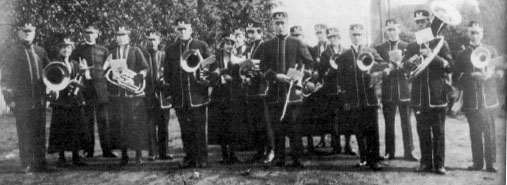
13. The Louisburg Band in Glace Bay for the Great War Veterans' Day Parade on September 17, 1919. Members are wearing their newly-arrived band uniforms. Left-right: Melvin S. Huntington, Erna MacLean, John A. MacDonald, Mary MacCormack, Jack Verner, Dunca n Lamont, Florie Ley, Danny Ferguson, Bel Verner, Harold MacQueen, Jessie MacCormack, Sadie MacCormack, Tina MacDonald, Walter Jewell, Arthur MacQueen, Guy B. Hiltz, Wesley Townsend.
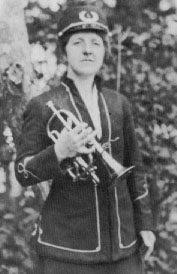 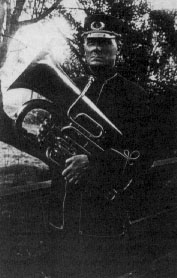 |
 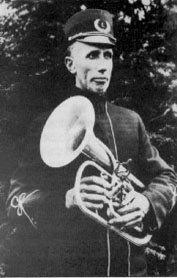 |
14. Individual studies of Band members in 1920. Erna MacLean, Melvin S. Huntington, Wesley Townsend, Archie Hare.
Though there are no band caps known to have survived, it is possible to provide a reasonable description based on the surviving tunics and photographs of the Band. The cap was a military forage cap design covered in material similar in colour to the tunic . It had a button on the top, a band of black ribbon lace and a shiny leather peak. On the front of the cap, above the peak, there was a brass wreath opened at the top with the letter "L" in the centre. There was a gold metallic cord across the front of t he cap anchored by buttons at the temple.
Band leader John A. MacDonald's uniform was slightly different. The tunic is navy blue serge with the standup collar and hook and eye closure as in the bandmens' uniform, though there is the addition of black braided shoulder straps. It has the black ribb on lace on collar, front and bottom hem. But there are also five double-width horizontal bands of ribbon lace across the chest. There is no gold braid as on the bandsmens' tunics. However, above the chevron of lace on each sleeve there is a crowsfoot design in thin black braid. The cap is similar to the bandsmens' but with the word "LEADER" in brass in place of the wreath and letter "L".
In 1920, there were at least 40 band rehearsals. On May 24 the Band was in Glace Bay once more playing at the Trotting Park. In June the Lodges of the Brotherhood of Railway Trainmen arrived in Louisburg to take part in their annual memorial service. The Band met them at the S&L train station and led them to St. Bartholomew's Church where the service was held. After the service the parade formed up again and returned to the station.54
On July 12, the Band boarded the schooner "M. O'Toole" for the community of Gabarus where it would lead the Orange Day procession and join in the picnic. Later in the month there was a return engagement with the Port Morien Masons' picnic at Sangaree Island on the Mira River.55 These opportunities to travel outside Louisburg are an indication that the Band had developed a solid local reputation for it's playing. But it also points to the interesting fact that, during this period at least, the T own does not seem to have organized events on public holidays to keep the Band employed in Louisburg. Even when the Band would remain in Louisburg, on May 24 or July 1, the parades and concerts were more self generated than participation in a celebration organized by the Town.
The most important event for 1920 was the visit by the Governor General, the Duke of Devonshire, on July 31. The Vice-Regal party was met at the station by an "enthusiastic crowd of citizens." The Pipe Band played several patriotic tunes and the Brass Ban d concluded the welcome with "God Save the King".56 There were greetings from Mayor A. A. Martell, who introduced members of the Town Council and, according to the Post correspondent, "The town itself was gay with flags, bunting and streamers o f red, white and blue. In the immediate vicinity of the station the decorations were the most noticed. A large arch trimmed in Empire Colours stood across the street from the station and bore in large letters the word - WELCOME. The two bands at the stati on played a splendid programme of patriotic airs and none seemed to please the distinguished visitors more than, 'The Maple Leaf Forever'. The turnout of the musical organizations added materially to the welcome of the Duke and his party."57
Additional Band participation for the year included a Liberal political meeting in the Masonic Hall addressed by D.A Cameron, A. B. McGillivrary and H. C. V. Levatte,58 and a concert at Fletcher Townsend's house on Labour Day.
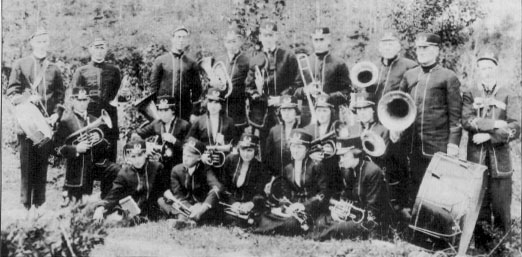
15. The Band in 1920 by C. W. Kelly of Sydney. Probably the Sangaree outing with the Port Morien Masons. Front Row. l-r: Arthur MacQueen, Harold Covey, Florie Ley, Erna MacLean, Viola Burke. 2nd Row. I-r: Walter Jewell, Mary MacCormack, Sadie MacCormack, Katie Morrison, Tina MacDonald, Jessie MacCormack. 3rd Row. l-r: Unidentified, John A. MacDonald - leader, Guy B. Hiltz, Wesley Townsend, Unidentified, Harold MacQueen, Duncan Lamont, Melvin S. Huntington, Danny Ferguson.
In 1921 Huntington mentions several dances and socials in the Masonic Hall.59 Dominion Day was celebrated by the Band playing for an hour at the corner of Main and Warren Streets in the lot where the Post Office now stands. It was also a Federal election year. The Band took part in a Liberal party Meeting in the Masonic Hall on 10 November, and was at the Conservative rally two weeks later.60 But in keeping with the tradition of the earlier Citizens' Band, there is no mention of it being present at Labor Party meetings.61
Finally, on December 17 the Band was in Peters' Hall for a presentation to H.C.V. Levatte who was leaving to take up residence in Halifax. Levatte, long-time resident of Louisburg and Warden of Cape Breton County, had served the County for over 40 years a nd was a major political force in the Town during that period.62
In 1922 there were dances in Peters' Hall and the Masonic Hall.63 It was also in 1922 that band member Erna MacLean married the band leader John A. MacDonald. The Band was at the S&L station to welcome them home from Boston where they had been married.64 On July 12, 1922 the Orange Day picnic was held on the grounds at the north-east end of Louisburg harbour. There were over five hundred "Orangemen and their friends" from Glace Bay in attendance. They were met at the S&L station by t he Band and, accompanied by the McDougall Band from New Aberdeen, paraded through the streets. The Methodist Congregation served refreshments in the old Salvation Army Barracks which was located just south of the turnoff from Main street to Havenside Road . A photograph taken that day shows bandmembers and Orangemen dancing on the rough temporary dance floor erected for the occasion.
In 1923 Louisburg received a visit from Governor General Julian Byng. Lord Byng had commanded the Canadian Corps in 1916 and planned the successful attack by the Canadians on Vimy Ridge. He was met at the S&L station, on July 27, by the Mayor A. A. Martel l, Council and citizens and shook hands with soldiers. This was followed by a luncheon in St. Bartholomew's Church Hall, a visit to the Marconi Station and the ruins of the 18th century Fortress of Louisbourg. The Brass Band played, "God Save the King" as Byng arrived and followed this up with selections during the luncheon, ending with, "O Canada" as the train pulled away from the station.
But life seems to have been slowing down for the Band in 1923, for Melvin Huntington mentions one dance in the Masonic Hall, and an October meeting in aid of the School for the Blind.65
Unlike the Citizens' Band, there is no formal notice in the newspaper that the Brass Band had disbanded. But in 1924 Huntington records just 4 practices, the last one on April 29. There is no further mention of the Band in his diaries or local newspapers.
The Band did not come to an end because it lacked a competent instructor, the major reason for the demise of the Citizens' Band. John A. McDonald still lived in Louisburg and would direct the choir of First United Church for many years.
One reason has been suggested by Guy M. Hiltz, lifelong resident and former mayor of the Town. He remembers his father, Guy B. Hiltz, saying that there was some sort of political disagreement that contributed to the demise of the band. There is no record of the nature of any disagreement, but the period was politically volatile, and there were strong Liberal and Conservative sentiments represented by band members.
Of equal significance were a number of small changes which, taken together, contributed to the Band fading away, rather than coming to an abrupt end. Tina MacDonald told me that she thought people had just stopped coming to practices. This is probably true and there were quite understandable reasons for this. For example, events in Melvin Huntington's personal life put the Band in second place. On July 15, 1924 he married Emeline Townsend and set up a new home for the first time when he was 49 years old. Though he remained in his post as a Town Councillor and continued to take an active role in the Methodist / First United Church choir, the Band was no longer a part of his social commitment.
Perhaps the most tragic event for the Band was the sudden death of 23 year old Viola Burke in June 1922. Huntington attended the funeral in the Stella Maris Church at the western boundary of Louisburg and writes that it, ". . . was the most largely attend ed I have seen in this town."66
Other band members were moving into a new phase of their lives as well. In 1921, Erna MacLean left Louisburg and the Band to go to Boston. At about the same time Tina MacDonald and Bel Verner also took their leave. The reason Tina gave me for leaving, when I visited her in 1989, was that playing meant she wasn't free to dance.67 In May 1922 Erna MacLean and John A. MacDonald were married and on April 10,1924 their first child was born. In the fall of 1922 Mary MacCormick left for the United States, sent off by a band-sponsored dance.68 On November 15, 1922 Harold MacQueen and Florie Ley married. In 1923 band member Archie Hare married,69 and in the fall 1924 Jessie MacCormack married Malcolm Macleod.70
Once the younger bandmembers married, particularly the ladies, their involvement in the Band came to an end. With the resumption of a pre-War conservatism, they were expected to turn their attention to the home and to more acceptable public participation such as church choirs. With half the Band gone by the fall of 1924, there were probably too few committed members left to continue the Band.
In addition to changes in personal circumstances, the end of the war removed a major reason for the Band's existence. Without the incentive of recruitment drives, Red Cross concerts and other activities associated with community patriotism, there were fewer calls on the Band's time. The participation outside the local community kept up the momentum for several years and provided the Band with a source of funding, but it was obviously not sufficient in the long term. In reality the Band was a hobby. It was but one expression of a more global interest in music held by individual members who took part in other activities such as concerts and choirs in addition to the Band. Individual members gained new musical skills or honed old ones, and found public ackno wledgement and a sense of contribution to the wellbeing of the community. But the Band was never an official organization in Town life though its presence, during the war, was appreciated. There were no contractual responsibilities or formal roles In the Town social structure to keep it in place or to ensure continuity once other priorities took precedence.
Still, though the Band came to an end, some former band members would direct their musical interests to participation in church choirs, while others, such as Danny Ferguson and Harold Covey moved on to form or take part in small local dance bands.71 Some others would pass on instruments to the new Band in the mid 1930's, while Wesley Townsend, Harold Covey, Melvin Huntington, Walter Jewell and Arthur MacQueen would be actively involved In its revival.
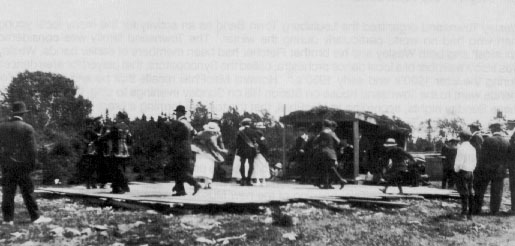
16. July 12, 1922. The Orange Day Picnic held in Louisburg.